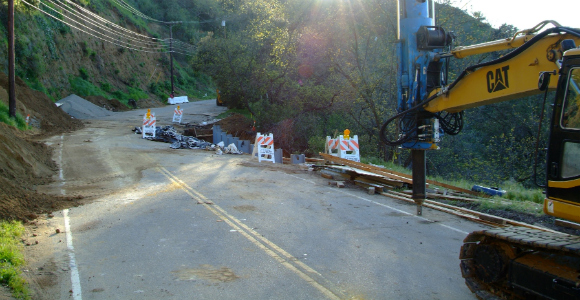
Road damage in Los Angeles. (Credit: FEMA)
Originally published on California Alliance for Jobs.
The California Local Streets and Roads Needs Assessment update released earlier this week says local streets and roads are in the shape they’re in largely for the same reason the state’s highway system is deteriorating — transportation funding hasn’t kept up with an ever-growing population and more cars on the road.
The report points out that:
The state’s population was about 30 million in 1990; it’s now 27 percent larger at about 38 million.
The cost of road repairs and construction has steadily increased, at rates significantly higher than inflation. Costs have risen eight-fold in just the past 15 years.
But despite more people and more cars, the state gas tax — the single most important funding source for fixing and maintaining roads — has been frozen at 18 cents per gallon for 20 years.
Another failed road
In addition, a number of federal and state requirements, such as improving handicapped access, increasing street cleaning to prevent pollutants from running off into creeks and rivers and even heavier natural gas-powered buses have diverted funding from road maintenance in the first two cases and increased wear and tear in the case of heavier buses.
As a result, while about 6 percent of local streets and roads are in failed condition today, that percentage will climb sharply to between 20 and 25 percent in 10 years if additional funding isn’t identified.
What can be done
Both at the state and local levels, a number of solutions have been proposed. At the local level, voters in 18 counties have approved some form of local sales tax to pay for targeted transportation projects in those counties. On Tuesday, voters in Alameda County will have the opportunity to extend and augment their transportation sales tax for 30 years by passing Measure BB.
Fully 19 percent of local transportation funding comes from these local sales taxes, and another 16 counties are considering asking their voters to enact them as well.
But at the state level, a number of solutions have been proposed, including:
Increasing the gas tax. Taking inflation and higher vehicle mileage into account, the 18 cent gas tax is now worth only 9 cents. Raising the tax to its real level in 1994 would raise an additional $1.7 billion a year.
Indexing the gas tax. Indexing the tax to keep pace with inflation would not have an immediate effect but would prevent road maintenance from future sharp decreases.
Return truck weight fees to the highway account. The Alliance and its allies in the transportation community this year attempted to restore the $1 billion trucks historically paid to road maintenance but state officials resisted.
Convert to a mileage-based fee. California will join Oregon and Washington in establishing a pilot program to charge motorists based on the miles they drive, regardless of whether they drive a gasoline powered vehicle or one powered by electricity, alternative fuels or fuel cells. As more drivers are expected to drive non-gasoline cars in the future, the impacts on the gas tax will be significant.
It would cost an estimated $78 billion over the next 10 years to bring our local streets, roads and bridges into optimal condition. While that seems like a lot, it would cost an average motorist just 74 cents a day.
Read our first blog post, Local road conditions continue to deteriorate.
Read our second blog post, Local roads edge closer to the cliff.
———————
Originally published on California Alliance for Jobs.

